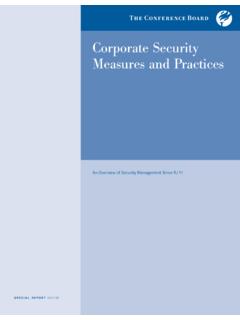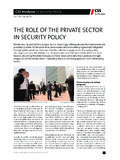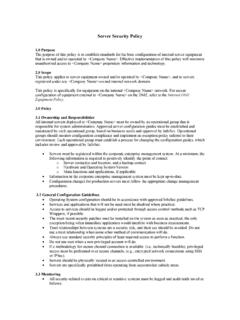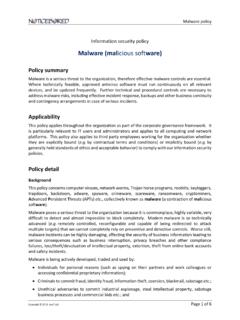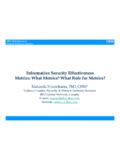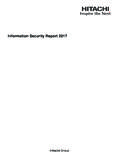Transcription of MEASURES METRICS In CORPORATE SECURITY
1 2011 SECURITY EXECUTIVE COUNCIL ALL RIGHTS RESERVED 1 MEASURES and METRICS In CORPORATE SECURITY : by George K. Campbell yy HUNDREDS OF PROVEN MEASURES AND METRICS yy TOOLS TO DEMONSTRATE THE EFFECTIVENESS OF YOUR SECURITY PROGRAM yy WORKBOOK FORMAT SECURITY Executive Council Publication Series 2011 SECURITY EXECUTIVE COUNCIL ALL RIGHTS RESERVED 2 ABOUT THIS PUBLICATION MEASURES and METRICS in CORPORATE SECURITY A Value Initiative Product: A Workbook for Demonstrating How SECURITY adds Value to Business George K. Campbell, SECURITY Executive Council Emeritus Faculty Member and former Chief SECURITY Officer at Fidelity Investments is author of the ground-breaking book, MEASURES and METRICS in CORPORATE SECURITY The risk environment has changed significantly over the past 30 years with shocking wake-up calls to CEOs, Boards and shareholders.
2 Campbell, an industry leader with over 30 years of executive-level SECURITY experience, leads a discussion on the surprising range of SECURITY MEASURES and METRICS options, deciding on the most significant data and how best, and to whom, to present it. This is a workbook intended to stimulate thought on what might be effective within your unique environment and guides the reader to develop their METRICS program. MEASURES and METRICS is more than a "how to"; it's about managing the SECURITY organization and aligning it with the business goals. With a background covering information SECURITY , disaster recovery planning, due diligence, criminal investigations, fraud prevention, property protection and SECURITY systems engineering, Campbell comes well-equipped to discuss the METRICS and measurements that make up a successful SECURITY program.
3 In this book he puts forth solid answers to the question, Why SECURITY METRICS ? At the same time he provides examples for addressing company-wide SECURITY concerns. This book contains useful information for both the public and private sectors, the new and experienced CSO, CISO, risk manager, auditor or executive with SECURITY responsibility as well as MBA and advanced SECURITY degree students. Reserve your copy of MEASURES and METRICS in CORPORATE SECURITY today at 2011 SECURITY EXECUTIVE COUNCIL ALL RIGHTS RESERVED 3 Intended Audiences: - SECURITY Professionals - Compliance Professionals - CORPORATE General Counsel - Sr. CORPORATE Executives - Internal and External Auditors - Ethics Officers - Risk Management Professionals - College-level Professors/Instructors of SECURITY -related Curricula - Students TABLE OF CONTENTS FORWARD 1.
4 THE BASICS Introduction Why measure , Why METRICS ? What Are SECURITY METRICS ? What Are the Components of a MEASURES and METRICS Program? What Is CORPORATE SECURITY ? The Need for a Consolidated View of SECURITY MEASURES The Business Context for METRICS The Balanced Scorecard The Risk Management Context for METRICS The Regulatory Context for METRICS The CSO s Context for METRICS The Legal Context - The Critical Value of a Policy Infrastructure An Opening Exercise: What s the Real Cost of SECURITY in Your Company? Good METRICS are SMART Keep Your MEASURES and METRICS in Proper Perspective Making the Workbook Work for You 2. TYPES OF METRICS & PERFORMANCE INDICATORS Influential Initiatives from the Corner Office The CSO Dashboard Risk Analyses Risk Rating or Ranking Risk Mapping Threat Assessment Vulnerability Assessment Cost Risk Benefit Analysis Leading Indicators A lagging indicator Value Indicators Criticality Ranking Confidence and Influence Indicators SECURITY Standards (aka.)
5 Guidelines) Task Analysis and Work Breakdown Structures Project Cost Estimating Baseline Performance METRICS Estimated Incident Costing And Consequence Analysis The Business Unit SECURITY Annualized Loss Expectancy Diagnostic MEASURES Business Hygiene and Insider Risk MEASURES Mapping 2011 SECURITY EXECUTIVE COUNCIL ALL RIGHTS RESERVED 4 3. BUILDING A MODEL APPROPRIATE TO YOUR NEEDS Introduction Does the Business we re in Make a Difference? What is the Most Important Data to the Enterprise and its Leaders? What Are the Most Important Data to the SECURITY Executive? What Should We measure ? What s the Goal? What Are Your Objectives With This Data? METRICS Can Bite How do I Get the Attention of Different Constituencies?
6 How Do We Present the Information to the Target Audience? Management of the Data What Tools Are in the Presentation Toolkit? Interpreting the Data Organizing For Success: Engaging a SECURITY Committee. What s Next? APPENDIX 1: Examples of SECURITY -Related MEASURES and METRICS 1. SECURITY Related Trends - General 2. Communicating Risk Knowledge 3. Audit Implications 4. Background Investigations 5. Due Diligence Examinations 6. Business Conduct & Reputational Risk 7. Criminal Incidents and Investigations 8. SECURITY Operations, Physical SECURITY & Premises Protection 9. Informational Risk Management 10. Contingency Planning & Business Continuity 11. Business-based SECURITY Programs 12. Confidence with the CORPORATE SECURITY Functions 13.
7 Management, Professional Development & Employee Satisfaction APPENDIX 2: Trade Associations and Other Organizations with SECURITY Voluntary Compliance Programs APPENDIX 3: Sample High-Level SECURITY Work Breakdown Structure APPENDIX 4: Physical SECURITY Cost Estimating Tables 1. SECURITY Devices, Equipment & Installation Labor Costs 2. Sample Template: Potential Components of Voluntary Compliance with C-TPAT APPENDIX 5: Risk measure Maps 1. Frequency and Severity of Workplace Violence Incidents 2. Increased Numbers of Employees as Subjects in Misconduct Cases 4. SECURITY Budget Reduction As Result of Decreasing CORPORATE Revenues 3. Business Interruption By Computer Virus 5. Failure of SECURITY to Respond to SECURITY Breach 2011 SECURITY EXECUTIVE COUNCIL ALL RIGHTS RESERVED 5 George Campbell is currently a member of the Emeritus Faculty of the SECURITY Executive Council.
8 He retired in 2002 as Chief SECURITY Officer at Fidelity Investments, the world s largest privately owned financial services firm. Under George s leadership, the global CORPORATE SECURITY organization delivered a wide range of proprietary services including information SECURITY , disaster recovery planning, background, due diligence and criminal investigations, fraud prevention, property protection and SECURITY system engineering. During the period 1989-92 George owned his own SECURITY -consulting firm and from 1978-89 was Group Vice President at a system engineering firm supporting worldwide Government SECURITY programs. His criminal justice career from 1965 to 1978 was spent in various line and senior management functions within federal, state and local government agencies. George received his baccalaureate degree (Police Administration) from American University, Washington, in 1965.
9 He is a Life Member and served on the Board of Directors of the International SECURITY Management Association from 1998-2003 and as ISMA s President in 2002-03. George is a member the American Society for Industrial SECURITY since 1978. He is former member of the High Technology Crime Investigation Association, the Association of Certified Fraud Examiners and an alumnus of the Department of State, Overseas SECURITY Advisory Council. 2011 SECURITY EXECUTIVE COUNCIL ALL RIGHTS RESERVED 6 1. THE BASICS Introduction. CORPORATE SECURITY organizations have long sought a catalog of METRICS or MEASURES that may be applied to reliably indicate the value they bring to the enterprise they serve. While easily focusing on the company s quarterly earnings, department budget runs and certain incident statistics, many CORPORATE SECURITY managers fail to utilize the volumes of data their operations generate that may be organized to provide a rich array of performance assessment tools.
10 This book is intended to provide some organizational measurements, concepts, METRICS , indicators and other criteria that may be employed to structure MEASURES and METRICS program models appropriate to the reader s specific operations and CORPORATE sensitivities. This is a workbook, and a work in progress, intended to stimulate thought on what might be effective within your unique environment. We briefly touch on multiple MEASURES and METRICS because there are so many alternatives and the workbook format may enable you to find one example that can be modified to accommodate your needs better than another. We need to share these ideas and hopefully future versions of this workbook will encompass examples of what has worked for you. Why measure , Why METRICS ? The fact that established METRICS and MEASURES for the full range of SECURITY programs are few and far between tells a story about the historical disconnection of these functions from the core businesses they serve.
